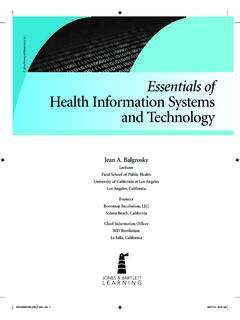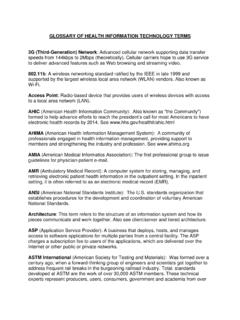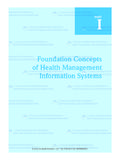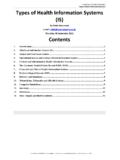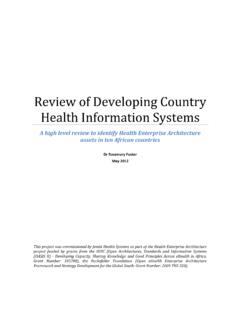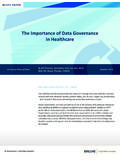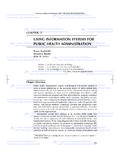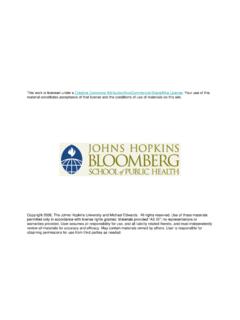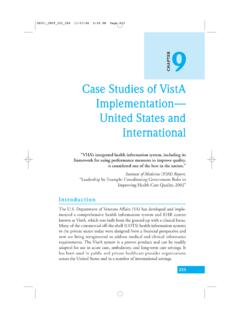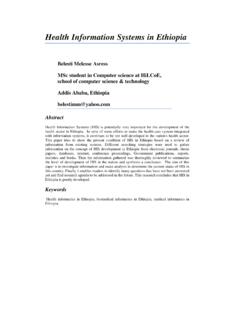Transcription of Support tool to assess health information systems …
1 Support toolto assess health information systems and develop and strengthen health information strategiesSupport toolto assess health information systems and develop and strengthen health information strategiesAbstractDuring its meeting of December 2013 the Standing Committee of the Regional Committee asked the WHO Regional Office for Europe to develop a practical Support tool for Member States. This tool is intended to assist Member States in developing and improving their national health information systems through the development of a national health information strategy, in order to Support them with implementation of health 2020. It is based on existing tools de-veloped by WHO s health Metrics Network. Good health information supports public health policy-making: it helps Member States identify health 2020 priority areas for action and evaluate the effects of health 2020-related policies and interventions. KeywordsSYSTEMS ANALYSISHEALTH information MANAGEMENT MEDICAL INFORMATICS APPLICATIONSDATA COLLECTIONKNOWLEDGEA ddress requests about publications of the WHO Regional Office for Europe to: Publications WHO Regional Office for Europe UN City, Marmorvej 51 DK-2100 Copenhagen , Denmark Alternatively, complete an online request form for documentation, health information , or for permission to quote or translate, on the Regional Office website ( ).
2 ISBN 978 92 890 5091 3 World health Organization 2015 All rights reserved. The Regional Office for Europe of the World health Organization welcomes requests for permission to reproduce or translate its publications, in part or in designations employed and the presentation of the material in this publication do not imply the expression of any opinion whatsoever on the part of the World health Organization concerning the legal status of any country, territory, city or area or of its authorities, or concerning the delimitation of its frontiers or boundaries. Dotted lines on maps represent approximate border lines for which there may not yet be full mention of specific companies or of certain manufacturers products does not imply that they are endorsed or recommended by the World health Organization in preference to others of a similar nature that are not mentioned. Errors and omissions excepted, the names of proprietary products are distinguished by initial capital reasonable precautions have been taken by the World health Organization to verify the information contained in this publication.
3 However, the published material is being distributed without warranty of any kind, either express or implied. The responsibility for the interpretation and use of the material lies with the reader. In no event shall the World health Organization be liable for damages arising from its use. The views expressed by authors, editors, or expert groups do not necessarily represent the decisions or the stated policy of the World health ..11. Leadership, coordination and assessment ..72. Review of results of HIS assessment ..143. Review of health system development priorities and definition of HIS problems ..164. Inventory of HIS strengthening activities ..195. Priority HIS components and problems ..216. The HIS vision ..247. Current and planned HIS strengthening efforts ..258. HIS objectives and interventions ..279. Intervention implementation phasing ..3210. Detailed strategy design and implementation planning ..3411. Strategy costing ..3912. Finalization, review and approval of strategy; strategy monitoring and periodic Translation of evidence into policy.
4 46 Annex 1. Glossary of terminology used ..55 Annex 2. Example table assessing national HIS resources: coordination, planning and policies ..58 Annex 3. health system domains ..59 Annex 4. Key HIS assessment items ..61 Annex 5. Example table for the HIS assessment outcomes with low-scoring key assessment items and HIS component average scores identified ..65 Annex 6. Example table of priority health problems and related health services (partly completed) ..66 Annex 7. Overview of current indicator sets in use by WHO, the European Commission and OECD ..67 Annex 8. Checklists of documents for use during modules 2 and 3 of phase 2 ..71 Annex 9. Example of scoring sheet with colour-coded scores ..72 Annex 10. Examples of HIS strengthening activities ..73 Annex 11. A note on constructing a vision of the future HIS ..74 Annex 12. Example of vision graphics and set of elements.
5 75 Annex 13. Example list of strengths, weaknesses, opportunities and threats ..76 Annex 14. Examples of HIS strategy design principles and criteria ..77 Annex 15. Consolidated HIS standard and possible strategic interventions ..78 Annex 16. Examples of costing summaries ..85 Annex 17. A note on HIS strategy monitoring and evaluation ..86 Annex 18. A note of guidance on preparing the HIS strategy and planning document ..87 IIIB oxes, figures and tablesBoxesBox 1. Content from HMN tools and newly added content ..1 Box 2. Leadership in health 2020 ..9 Box 3. The health 2020 monitoring framework ..17 Box 4. Policy priorities in health 2020 ..22 Box 5. Data linkage: technical and legal 1. Roadmap to applying the HMN framework and standards for country HIS ..3 Fig. 2. Support tool structure flowchart ..4 Fig. 3. The HMN framework ..12 Fig. 4. strategies for linking research to action ..48 TablesTable 1. Assessment categories with total number of questions/items.
6 13 Table 2. Example summary table for HIS assessment outcomes ..15 Table 3. health 2020 core indicators ..18 Table 4. Example of a partly completed worksheet of ongoing and planned HIS strengthening efforts ..20 Table 5. Example of a partly completed worksheet of HIS component problems and interventions ..23 Table 6. Example HIS objectives and indicators ..29 Table 7. Summary of HIS objectives and interventions ..31 Table 8. HIS intervention implementation phasing sheet ..33 Table 9. HIS activity implementation plan for initial implementation period (partly completed as an example) ..36 Table 10. HIS strategy resource requirements (partly completed as an example) ..40 Table 11. Example common cost elements and factors ..41 Table 12. HIS strategy objective and target achievement evaluation framework ..43 Table 13. HIS component strategy implementation monitoring ..43 Table 14. Uses of data and research evidence in the policy-making its meeting of December 2013 the Standing Committee of the Regional Committee asked the WHO Regional Office for Europe to develop a practical Support tool for Member States.
7 The tool was intended to assist Member States in developing and improving their national health information systems (HIS) through the development of a national health information strategy, in order to Support them with implementing health Good health information supports public health policy-making: it helps Member States identify health 2020 priority areas for action and evaluate the effects of health 2020-related policies and Support tool was developed by a working group consisting of representatives of 17 Member States, co-chaired by Professor Hans van Oers , Chief Science Officer, National Institute for Public health and Environment (RIVM), from the Netherlands and Dr Anna Korotkova, Director s Advisor on International Affairs, Federal Research Institute for health Organization and Informatics of the Ministry of health , the Russian Federation, together with Mr Nick Fahy, an external consultant, and the WHO Secretariat. The tool was based to a large extent on existing frameworks and tools developed by the health Metrics Network (HMN)2 (see Box 1).
8 Further tools available to Support the implementation of health 2020 in the WHO health information and evidence portalIn September 2014 the WHO Regional Office for Europe launched the health information and evidence This is an activity of the European health information Initiative a multipartner network aimed at improved knowledge sharing, capacity-building and harmonization of efforts and outputs in the field of health information in portal is structured according to policy-relevant themes, of which health 2020 is one; other themes include noncommunicable diseases (NCDs), antimicrobial resistance and obesity, physical activity and nutrition. For each of these, the portal makes available both quantitative (such as interactive data visualizations and country profiles) and qualitative information , which comprises organization, networks and projects; tools for monitoring and policy Support ; sources of evidence and good practices; and policy documents and analysis reports.
9 It thus provides further resources and tools that Support the implementation of health 2020, and more will be added over time as the portal is updated health 2020: a European policy framework and strategy for the 21st century. Copenhagen: WHO Regional Office for Europe; 2012 ( , accessed 7 November 2014). 2 HMN toolbox [website]. Geneva: World health Organization; 2014 ( , accessed 7 November 2014).3 health information and evidence portal [website]. Copenhagen: WHO Regional Office for Europe; 2014 ( , accessed 7 November 2014).Introduction2 Support tool to assess health information systems and develop and strengthen health information strategiesThe existing frameworks and tools developed by HMN (available via the HMN website2) were used as a basis for this tool in particular: assessing the national health information system : an assessment tool, version ; assessment score sheet; guidance for the health information systems (HIS) strategic planning process: steps, tools and templates for HIS systems design and strategic parts of the text in this Support tool are directly derived from these HMN tools.
10 For the purpose of the Support tool the contents of the HMN assessment tool and HIS strategic planning guidance document were merged and made more concise: only those tables, figures and annexes most important for understanding the entire assessment and strategy development process were reproduced. More examples and supporting information are thus available in the original original HMN tools are mainly designed for use by low- and middle-income countries. To make this Support tool more suitable for Member States in the WHO European Region, information relevant to the European context was added in several sections, mostly in the form of boxes. Indicator sets from WHO, the European Commission and the Organisation for Economic Co-operation and Development (OECD) currently in use in the Region were also included. Finally, a separate chapter on translation of evidence into policy was added to provide users of the tool with additional resources to enforce this essential phase in the health information the Support toolThis tool covers all the phases related to health information strategy development from assessment of the current state of HIS through strategy development and implementation to evaluation.










